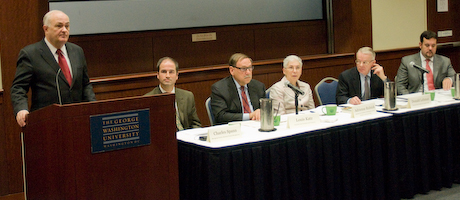By Menachem Wecker
Move over Oprah; there’s a new book club in town.
On Dec. 4, a panel of University administrators discussed the ways Thomas Friedman’s book Hot, Flat and Crowded, this year’s selection for the Freshman Reading Program, relates to sustainability efforts on campus. Mr. Friedman will be on campus for a Jan. 21 event related to the book.
“This is kind of a milestone for us,” said GW President Steven Knapp in an introduction, announcing the creation of a new GW Climate Action Plan (CAP).
On Earth Day 2008, Dr. Knapp signed the American College and University Presidents’ Climate Commitment, which committed GW to create an inventory of its carbon footprint. The CAP will respond to the findings of the inventory, Dr. Knapp said.
The University will identify areas in which it can save in its business processes by cutting energy use, which could free up funds for other areas that will advance the University’s stature. “Broad participation is what we are looking for,” Dr. Knapp said.
The panelists at the Dec. 4 event were Charlie Spann, managing director of information systems and services and business process management; Louis Katz, executive vice president and treasurer; Donald Lehman, executive vice president for academic affairs; Adrienne Rulnick, associate vice president of development, alumni relations and annual giving; and Louis Lemieux, chief human resources officer. Meghan Chapple-Brown, director of GW’s Office of Sustainability, moderated the discussion.
“Anything we can do as a University to reduce the consumption of resources and eliminate waste is something good from the University’s perspective and is obviously a social good,” said Mr. Katz.
Sustainability is an issue that offers a unique opportunity for “synergy” at a large institution, Mr. Katz said. “This is something that everyone can rally around.”
Dr. Lehman, who taught a course on physics and the environment in 1975, said he was thrilled when Fred Siegel, associate vice president and dean of freshmen, conveyed students’ recommendation to use Mr. Friedman’s book for the freshman reading project. “The good news basically is that the students picked this book,” Dr. Lehman said.
The essence of the book is that there is a crisis, Dr. Lehman said, and over the decades since he taught the course on the environment, there has not been a lot of progress. “That’s disturbing,” he said. But though there is a need for change, Mr. Friedman’s book articulates the problems without offering any solutions, Dr. Lehman said.
According to Dr. Rulnick, her division has been trying to find its own solutions, from creating a “green alumni network” on LinkedIn to sending copies of Mr. Friedman’s book to 50 high schools that send graduates to GW. The next freshman class may include lots of students who have already read the book, she said.
GW’s Information Systems and Services is also trying to be as environmentally friendly as possible, said Mr. Spann, particularly since ISS is a large consumer of electricity. Mr. Spann said his department has just unveiled a more efficient data center that will virtualize more than 80 percent of GW’s servers, allowing the University to run multiple servers through one power supply and cutting the costs of running and cooling the servers in half, he said. ISS is also eliminating older and less efficient servers and running a document management system that lets students store their papers online, reducing the need to print.
Just as Mr. Friedman argues that sustainability is a great opportunity for the United States, it can be a great opportunity for GW, Mr. Spann said.
One such opportunity may be virtual offices, where staff members can work at home and save energy by eliminating commutes, said Mr. Lemieux.
But according to the panelists, there are also many challenges to running a green campus at GW.
Even if ISS swaps bulky, less environmentally friendly computer screens for thinner, more efficient ones, it still has to find a way to dispose of all the old screens without creating a larger environmental problem, Mr. Spann explained.
Mr. Katz explained that though GW has won awards for its new sustainable buildings, it is much harder to “green” older buildings on campus, because they are continually in operation. GW must find a way to be more sustainable while working with its existing infrastructure, he said.
Despite all the challenges, GW has a chance to have a big academic impact by training students to have a civic impact after they graduate, according to Dr. Lehman. “I think GW has an opportunity to be a model,” he said.


